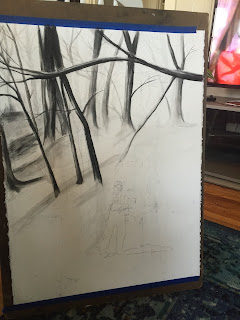Final Project
Proposal
For my final project I am going to
further explore my interest in both monotypes and fabric by combining them.
Bringing together the looseness of the monotypes with the conceptual ideas I
have been dealing with in fabric is something I have wanted to do for a while.
I plan on doing a monotype suite of my dad using four separate pieces of cloth,
roughly 5ft x 3ft. I will work from reference photos of the figure doing a
movement, such as crossing their legs or standing up out of a chair. The prints
will be printed on sheer fabric, such as 8mm china silk, and somewhat
transparent. Each print will be visually interesting when viewed individually;
however, when the prints are stacked up and backlit, the prints will coalesce
together and show the movement of the figure.
The
monoprints will be installed in a way that allows them to be seen both
separately and stacked on top of each other. The sides and bottom of the fabric
will remain raw, and I will keep the fabric loose for most of the sides and
bottom, but support the top by attaching wire to the fabric or sewing wooden
dowels into the fabric—much like boning in the bodice of a dress. The viewer
will be able to interact with the installation by moving the fabric apart or
together; this will be visually exciting because the image will change from
individual works to one piece, incorporate the movement of the fabric, as well
as allow the viewer to physically interact with the artwork.















